What Are Some Rare Coins to Look for in Your Grandfather’s Collection?
Posted onThe pursuit of rare coins often involves a combination of exploration and networking. Coin shows, reputable dealers, auctions, and numismatic events can be excellent channels for acquiring unique, valuable pieces. While these avenues are fruitful, rare coins can also be serendipitously found closer to home, namely, within the confines of your family’s history! This article will explore what rare coins to look for in your forebears’ collections, discussing:
- The elements that make a coin rare.
- Rare US coins that can be found tucked away in your family’s heirlooms.
- Foreign rare coins to look out for within your family’s legacy trove.
Watch this video for a list of rare coins to look for: https://www.youtube.com/watch?v=x2ADkijyYmA
What to look for in rare coins
While a coin’s scarcity undoubtedly contributes to its value, it’s essential to note that valuable coins are not exclusively synonymous with rare ones. The rarity of a coin is determined by various attributes. These are the main elements that allow us to classify a coin as “rare”:
- Mintage numbers: Mintage plays a pivotal role in defining a coin’s rarity. When a coin is produced in limited quantities, it becomes inherently scarce. When it comes to what to look for in rare coins, it can generally be argued that the lower the mintage, the higher the likelihood that the coin will be deemed rare and sought after by collectors.
- Age: As coins age, their numbers naturally dwindle due to factors like wear, loss, or destruction. It is important to identify rare coin years to look for. Older coins, particularly those from historically significant periods, become increasingly scarce. Their limited availability over time contributes significantly to their allure among collectors.
- Grading: The condition of a coin is crucial in determining its rarity. Grading involves assessing a coin’s condition and preserving its quality. Numismatists rely on established grading systems to evaluate factors like wear, luster, and overall preservation. A higher grade signifies better condition, adding to a coin’s rarity.
- Varieties and errors: Coins with unusual variations in design or errors not found in the standard issues can be considered rare. Some examples of rare coins to look for include misprints, die breaks, or double strike errors. Collectors often seek these coins due to their distinctiveness.
- Demand: High collector interest in a particular coin can increase its perceived rarity, especially if the demand exceeds the available supply. Coins sought after for their historical significance, unique features, or cultural relevance often become rarer due to heightened demand, contributing to their overall value in the numismatic market.
Rare US coins to look for in your grandfather’s collection

Dedicated coin aficionados will, no doubt, be familiar with the Capped Bust Dime. As the first dime that stated its face value on the coin, the Capped Bust Dime is considered a classic and constitutes one of the most popular American rare valuable coins to look for.
Capped Bust Dimes were designed by engraver John Reich and produced from 1809 to 1837. Featuring the Liberty bust wearing a Phrygian cap, a symbol of freedom, the series’ design is highly regarded for its artistic appeal.
Another noteworthy aspect of Capped Bust Dimes that makes them some of the top rare American coins to look for lies in the fact that they were created during a transitional phase of minting processes. The time of their creation marked a period when the United States Mint in Philadelphia was experimenting with different edge varieties. Notably, the 1834 Capped Bust Dime holds a unique position within the series due to its lettered edge. Adding a layer of uniqueness to the coin, this lettered edge marked a departure from traditional denticles and paved the way for the subsequent move towards plain edges, highlighting the dynamic nature of minting practices.
The 1834 Capped Bust dime is also notable because it represents one of the early years in which steam press technology was utilized. In the early 1830s, the United States Mint was transitioning from using screw presses to steam-powered coining presses. The introduction of steam technology significantly increased the efficiency of the minting process, allowing for higher production volumes and more consistent coin quality. As a result, coins from this period often exhibit sharper details compared to some earlier issues.
While Capped Bust Dimes can be difficult rare US coins to look out for in higher Mint State grades, you can see an exceptional MS64 graded one here:
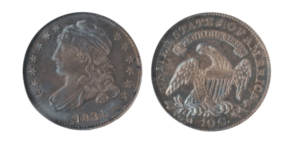
1834 Capped Bust Dime NGC MS64 CAC
Metal: Silver
Year: 1834
Check our most current price here.
Feel free to reach out to Blanchard’s team for any inquiries or a rare coin look-up; they are readily available to assist you with your numismatic questions.
Circulated rare foreign coins to look for
🇨🇦 Rare Canadian coins to look for
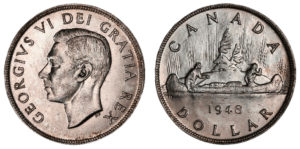 1948 Canada Dollar
1948 Canada DollarCanadian Silver Dollars were minted from 1935 to 1967. First introduced to commemorate the Silver Jubilee of King George V, the coin’s original design featured a portrait of the King on the obverse and a voyageur and Native American on the reverse. Over time, the designs of these coins were updated but always included portraits of reigning monarchs along with symbols of Canadian heritage.
Within the Canadian Silver Dollar series, the 1948 Canadian Silver Dollar edition carries a special and unique status in terms of rare dollar coins to look for. Minted to mark Canada’s centennial celebration of responsible government, a portrait of King George VI by T.H.Paget graces the coin’s obverse, while the reverse boasts a captivating voyageur design by acclaimed artist Emanuel Hahn.
What distinguishes the 1948 Canada Dollar, however, goes beyond its visual appeal. Its allure lies mostly in its historical significance. During World War II, the production of silver coinage came to a halt, as metal resources were redirected toward the war effort. The 1948 Canadian Silver Dollar was the first silver coin issued in Canada post-war, marking a symbolic resumption of normality.
Adding to the coin’s historical significance is the backdrop of India’s independence in August 1947. Preceding this milestone, Canadian silver dollar coins featured the inscription “GEORGIVS VI D:G:REX ET IND:IMP:”, which stood for “George VI By the Grace of God King and Emperor of India.” The transition to new dies reflecting India’s independence resulted in a delay in production in 1948, impacting mintage numbers, which amounted to a mere 18,780 pieces.
The above factors combined enhance the desirability of this iconic coin, making it one of the most special Canadian rare coins to look out for.
🇬🇧 Rare UK coins to look out for
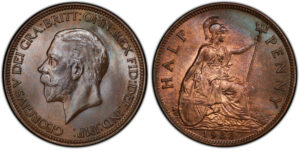 1933 George V ½ Penny
1933 George V ½ PennyBritain stands as a veritable treasure trove for numismatists, offering a rich and diverse array of historical coins that span centuries. Historical British coins tell a tale, reflecting the socio-political changes, cultural shifts, and artistic evolution that have shaped the nation over time.
The 1933 George V Half Penny is no exception. It is a prime example of what makes British numismatics a fascinating field and one of the most rare English coins to look out for if your forefathers had connections to the country.
This special coin was struck in a year that holds a special significance in British numismatics. More specifically, in 1933, the United Kingdom transitioned from using bronze for its coinage to a more cost-effective composition of copper-plated steel. This was due to economic challenges brought on by the Great Depression, which prompted a reassessment of coinage materials and costs.
The change in coinage materials and the general global economic downturn of the times also led to limited mintage numbers, which contributes to the rarity of these coins and makes them valuable for collectors today.
Nevertheless, it is important to note that the halfpenny was demonetized in 1984, and has not been used as legal tender since. This means that, while it may not be one of the most commonly encountered rare British coins to look out for, finding it would take a stroke of extraordinary luck, rendering the discovery exceptionally special.
🇦🇺 Rare Australian coins to look out for
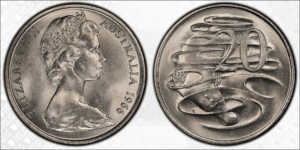 1966 Australian Wavy “2” 20-Cent
1966 Australian Wavy “2” 20-CentCollectors of modern coins and those intrigued by pieces with a distinctive origin may already be familiar with the remarkable and elusive piece that is the 1966 Australian Wavy “2” 20-Cent. A variety of the 1966 London Mint Australian 20 Cent, the Wavy “2” is distinguished by the presence of a wavy baseline beneath the numeral “2”, setting it apart from the standard version of the coin produced that same year.
The distinctive wavy baseline on the 1966 Wavy “2” 20-cent coin emerged during the minting process at the London Mint. While the origin of this peculiar feature is unconfirmed, it is speculated to be a result of an experiment or anomaly in the die preparation. And, as is often the case in numismatics, it is this unexpected and fascinating element to the coin’s design that drives its allure among collectors.
What further contributes to the coin’s “Rare coins to look out for: Australia edition” status is its mintage numbers. Whilst its exact mintage is not precisely known, it is believed to be relatively low compared to the regular 1966 20-cent coins.
The Wavy “2”’s accidental creation, distinct design error, and undisclosed mintage quantity make it a thrilling rare coin to look for in your family’s ancestral vaults.
🇨🇭 Rare coins to look for in Switzerland
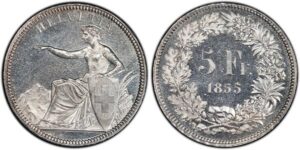 1855 Swiss 5 Francs issued by Solothurn
1855 Swiss 5 Francs issued by SolothurnAs far as rare world coins to look for are concerned, numismatists are bound to be drawn to the allure of Swiss 5 Franc Shooting Thalers. Crafted from the early to mid-1800s through the early 1900s, during a period when shooting festivals held great cultural significance in Switzerland, these coins encapsulate a unique blend of artistic expression and historical context.
Designed by various distinguished engravers, including Antoine Bovy, Friedrich Fisch, and Karl Schwenzer, Swiss Shooting Thalers were crafted to commemorate marksmanship. This is evident by the designs they bear, typically featuring rifles, crossbows, and other imagery related to shooting sports, along with symbols representing the specific canton or region hosting the shooting festival.
Among Swiss Shooting Thalers, the 1855 5 Francs issued by the town of Solothurn is a very special piece, as it held the distinction of being the sole Shooting Festival commemorative coin officially recognized as legal tender. This means that collectors who have a familial connection to Switzerland and are interested in rare silver coins to look for have a chance of coming across one, albeit given exceptional luck.
Another important thing to note about the 1855 5 Francs by Solothurn is that its edge lettering contains a spelling mistake in the word “Freischiesen”. The correct spelling of the word, which translates to “Shooting festival”, is “Freischiessen”. As tends to be the case in the world of numismatics, however, this error only adds to the appeal of this remarkable piece.
How to look for rare coins on Blanchard
While it doesn’t happen often, it is not unheard of for rare coins to hide in plain sight, going unnoticed within the confines of our ancestors’ collections. This adds an intriguing layer to the pursuit of rare pieces and underscores the importance of a discerning eye.
Notwithstanding, collectors do not have to rely on luck but, rather, can look up rare coins and source extraordinary pieces on Blanchard. Refer to Blanchard’s Rare Coins section for further insights into more valuable rare coins.
Want to read more? Subscribe to the Blanchard Newsletter and get our tales from the vault, our favorite stories from around the world, and the latest tangible assets news delivered to your inbox weekly.







